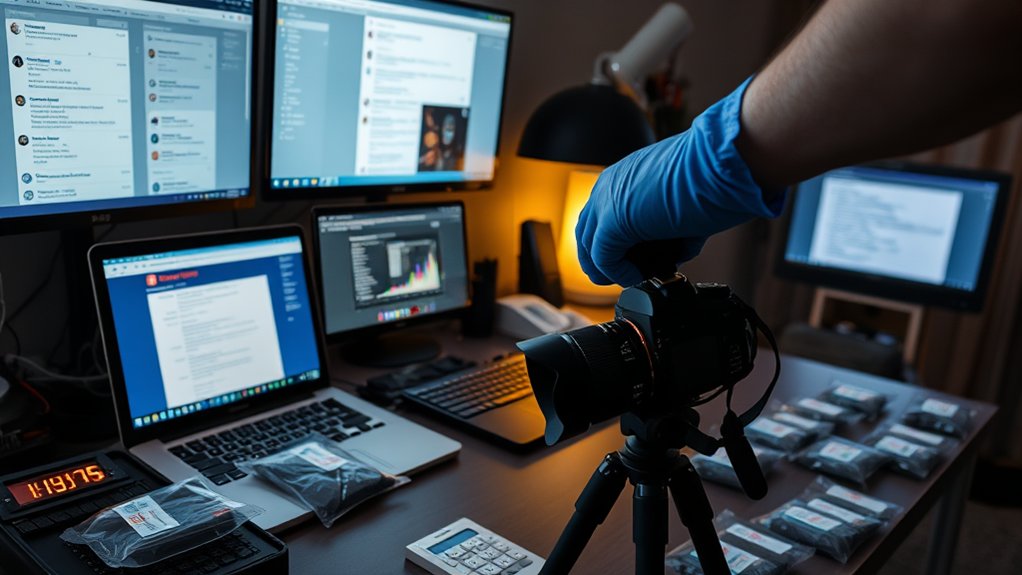Private investigators utilize specialized digital forensics software to systematically collect cyberbullying evidence across platforms. They capture screenshots, archive web pages, extract email headers, and preserve chat logs while maintaining proper chain of custody. Advanced monitoring tools enable automated profile tracking and data validation to identify fake accounts. Investigators employ sophisticated recovery technologies to retrieve deleted content and correlate cross-platform activities. Understanding these technical methods reveals the all-encompassing approach needed for building strong cyberbullying cases.
Key Takeaways
- Private investigators use specialized forensics software like EnCase and FTK to extract, preserve, and analyze electronic evidence from devices.
- They systematically capture screenshots, archive web pages, and collect email headers while maintaining proper chain of custody documentation.
- Social media monitoring tools allow investigators to track harassment patterns through keyword alerts, sentiment analysis, and automated captures.
- Investigators employ data recovery technologies to retrieve deleted content and access cloud-based backups of relevant cyberbullying evidence.
- Digital tracking methods help identify anonymous cyberbullies through IP address tracking, linguistic analysis, and cross-platform behavioral patterns.
Understanding Digital Footprints and Evidence Types

Documenting cyberbullying requires understanding how digital interactions leave persistent traces across online platforms. Each online action creates fragments of data that form an individual’s digital identity, from social media posts and comments to messaging app conversations and email exchanges. These digital footprints become essential evidence in cyberbullying investigations.
Investigators categorize evidence into direct communications, such as threatening messages or harassing posts, and indirect evidence like timestamps, IP addresses, and metadata. Understanding patterns of online behavior helps establish the scope and severity of cyberbullying incidents. Key evidence types include screenshots, archived web pages, email headers, chat logs, and system logs that record user activities. This digital trail enables investigators to reconstruct the sequence of events and verify the authenticity of reported incidents. Private investigators must maintain ethical investigation practices while gathering digital evidence to ensure admissibility in legal proceedings.
Essential Tools and Software for Online Investigation
Investigators employ specialized digital forensics software tools to extract, preserve, and analyze electronic evidence of cyberbullying activities across devices and platforms. Social media monitoring applications provide automated tracking of targeted harassment patterns, message archives, and user behavior analytics that meet evidentiary standards. Data recovery technologies enable the retrieval of deleted content, metadata, and digital artifacts that can establish timelines and authenticate cyberbullying incidents. Professional investigators typically hold computer forensics certifications to validate their expertise in gathering and analyzing digital evidence.
Digital Forensics Software Tools
Several digital forensics tools serve as essential components in gathering and preserving cyberbullying evidence. Industry-standard software like EnCase and FTK (Forensic Toolkit) enable investigators to capture and analyze digital communications while maintaining chain of custody. These tools incorporate robust encryption and documentation features to guarantee digital privacy during investigations.
Specialized programs such as Cellebrite and Oxygen Forensics focus on extracting data from mobile devices, social media platforms, and messaging applications. When implementing these tools, investigators must balance ethical considerations with the need to collect thorough evidence. Advanced features include metadata analysis, deleted content recovery, and timeline reconstruction capabilities. Modern forensics software also provides court-admissible reporting functions, allowing investigators to present findings in a standardized, professional format that meets legal requirements.
Social Media Monitoring Apps
While digital forensics tools focus on data extraction and preservation, social media monitoring applications offer real-time surveillance and analysis capabilities for ongoing cyberbullying investigations. These specialized apps track social media trends across multiple platforms simultaneously, enabling investigators to identify patterns of harassment and document threatening behavior as it occurs.
Modern monitoring tools maintain user privacy compliance while providing essential features such as keyword alerts, sentiment analysis, and automated screenshot capture of potentially harmful content. Investigators can establish digital timelines of cyberbullying incidents, track engagement metrics, and generate extensive reports detailing the frequency and severity of online harassment. Advanced applications also offer geolocation tracking, network visualization, and cross-platform correlation to help identify connected accounts and potential multiple perpetrators operating in coordination.
Data Recovery Technologies
Data recovery technologies represent a vital arsenal of digital investigation tools designed to retrieve, reconstruct, and analyze deleted or corrupted content from various electronic devices and online platforms. These sophisticated tools enable investigators to recover essential evidence from digital storage devices, including hard drives, smartphones, and cloud services.
Advanced data recovery software can restore deleted messages, photos, browsing history, and social media interactions that cyberbullies attempt to conceal. Forensic tools like EnCase, FTK, and Cellebrite specialize in retrieving data from damaged or deliberately wiped devices. Additionally, cloud-based recovery solutions help investigators access backed-up content from platforms like iCloud and Google Drive, even after deletion from local devices. These technologies guarantee that digital evidence remains accessible for building thorough cases against cyberbullying perpetrators.
Social Media Evidence Collection Techniques
Documenting cyberbullying evidence on social media platforms requires systematic screenshot capture methods, including full-page snapshots with visible timestamps and URL information. Digital investigators can utilize specialized social media tracking tools that archive posts, messages, and interaction patterns while maintaining data integrity through metadata preservation. Modern evidence collection software enables automated profile monitoring across multiple platforms, creating thorough records of harassing behavior with proper chain-of-custody documentation. Data validation techniques are essential for cross-checking gathered information and identifying potential fake accounts or misleading content.
Screenshot Documentation Methods
Several proven methods exist for capturing and preserving social media evidence of cyberbullying through screenshots. The screenshot purpose extends beyond mere documentation, serving as legally admissible evidence when properly collected and authenticated. Investigators employ specialized software that records metadata, timestamps, and URL information alongside the visual content.
Screenshot best practices include capturing the entire webpage, including scroll-length content, through full-page screenshot tools. Investigators document the date, time, and account details visible in the screenshot, while maintaining an unaltered chain of custody. Multiple screenshot formats are typically saved, including both standard image files and forensically sound PDF versions. Each screenshot receives a unique identifier and is stored securely with backup copies, ensuring the evidence remains intact for potential legal proceedings.
Social Profile Tracking Tools
Investigators routinely employ specialized social profile tracking tools to monitor, collect, and analyze digital evidence across multiple social media platforms. These tools utilize advanced social media analytics to document profile activity, interactions, and digital footprints left by potential cyberbullies and their targets.
Professional investigators rely on several key capabilities when selecting tracking tools:
- Automated timeline capture that records post history, comments, and engagement metrics
- Cross-platform monitoring to track linked accounts and shared content across networks
- Metadata preservation that maintains digital authenticity and chain of custody
- Real-time alert systems that flag threatening language or concerning behavioral patterns
These technological solutions enable investigators to build detailed evidence portfolios while maintaining compliance with legal requirements and privacy regulations. The data collected becomes essential for case building and potential legal proceedings.
Documenting and Preserving Electronic Communications
Preserving digital evidence requires systematic collection and storage of electronic communications related to cyberbullying incidents. Investigators employ specialized software to capture and archive email preservation records, ensuring message headers, timestamps, and routing information remain intact. They maintain detailed communication logs of text messages, social media interactions, and instant messaging conversations, documenting both the content and metadata of each exchange.
Professional investigators utilize digital forensics tools to create exact copies of electronic communications while maintaining chain of custody. They store evidence in encrypted formats with restricted access, preventing unauthorized modifications. Each piece of evidence receives unique identifiers, timestamps, and authentication measures to establish credibility in legal proceedings. Screenshots, system logs, and network traffic data supplement the documentation process, creating thorough records of cyberbullying activities. With their certified forensic expertise, investigators can typically complete mobile device analysis within a few hours to extract critical cyberbullying evidence.
Chain of Custody in Digital Evidence Gathering

Digital chain of custody protocols guarantee the authenticity and reliability of cyberbullying evidence through systematic documentation of all access, transfers, and modifications. Professional investigators utilize strict chain management procedures to maintain evidence integrity from collection through presentation.
Essential steps in maintaining digital evidence chain of custody:
- Recording initial discovery details including timestamps, locations, and device information
- Implementing tamper-evident digital signatures and hash values to verify data authenticity
- Logging every transfer between authorized personnel with detailed timestamps and purposes
- Securing evidence in access-controlled storage with encrypted backups
This methodical approach guarantees admissibility in legal proceedings while protecting victims’ interests. Each documented step creates an unbroken timeline of evidence handling that validates its authenticity and strengthens the investigation’s credibility. Investigators typically complete mobile device acquisitions within one hour to minimize potential evidence contamination.
Legal Requirements and Admissibility Standards
While proper chain of custody procedures establish evidence authenticity, specific legal standards govern the admissibility of cyberbullying evidence in court proceedings. Private investigators must guarantee legal compliance through proper authorization, documentation, and adherence to relevant privacy laws when collecting digital evidence.
The admissibility criteria for cyberbullying evidence typically require investigators to demonstrate that the evidence was obtained lawfully, remains unaltered, and directly relates to the case. Courts examine factors such as source verification, timestamp accuracy, and metadata integrity. Digital evidence must be collected using forensically sound methods that preserve original data while creating verifiable copies. Additionally, investigators must maintain detailed logs of all collection procedures, access controls, and storage methods to validate the evidence’s authenticity and reliability throughout legal proceedings. Similar to traditional background check services, investigators must follow strict confidentiality protocols and comply with relevant regulations to protect sensitive personal information.
Tracking Anonymous Online Harassers
Many anonymous cyberbullies employ sophisticated techniques to mask their digital footprints, requiring investigators to utilize advanced tracking methods and specialized tools. Through systematic analysis of online harassment patterns, investigators can isolate key identifiers and digital traces that lead to anonymous user identification.
Key investigative methods include:
- IP address tracking through court-authorized digital forensics
- Linguistic analysis of communication patterns and writing style
- Cross-platform correlation of posting times and behavioral signatures
- Metadata extraction from uploaded images and content
These technical approaches, combined with established digital forensics protocols, enable investigators to build thorough profiles of anonymous harassers. When multiple data points align, investigators can often establish connections between seemingly unrelated online accounts, helping to unmask perpetrators while maintaining proper evidence collection standards for potential legal proceedings. Similar to tracking unexplained absences in infidelity cases, investigators meticulously document unusual online behavioral patterns to build compelling evidence.
Building a Strong Cyberbullying Case File

To establish a legally defensible cyberbullying case, investigators must systematically compile thorough documentation that captures the full scope and impact of the harassment. Proper case file organization requires meticulous evidence categorization and indexing of all collected materials.
| Evidence Type | Documentation Requirements |
|---|---|
| Screenshots | Timestamps, URLs, device info |
| Messages | Original format, metadata intact |
| Witness Statements | Signed, dated declarations |
| Digital Forensics | Chain of custody forms |
Investigators maintain detailed logs tracking when and how each piece of evidence was obtained, who handled it, and where it is stored. This systematic approach guarantees all materials remain admissible in legal proceedings while demonstrating the persistent nature of the harassment through chronological organization. The case file serves as the foundation for any subsequent legal action. Similar to their work in insurance fraud investigations, private investigators employ advanced digital forensics to validate and document online harassment claims.
Frequently Asked Questions
How Much Does a Cyberbullying Investigation Typically Cost?
Professional cyberbullying investigations typically range from $500-$2,500, varying based on investigative tools evaluation complexity, required prevention strategies implementation, digital forensics depth, and case duration requirements.
Can Private Investigators Recover Deleted Social Media Posts and Messages?
Private investigators use digital forensics tools and specialized social media recovery software to retrieve deleted content from device caches, server backups, and archived data through legal investigative methods.
How Long Does a Typical Cyberbullying Investigation Take to Complete?
Investigation duration varies from one to six months depending on evidence collection complexity, number of platforms involved, accessibility of digital records, and cooperation from service providers.
Do Private Investigators Work Directly With Law Enforcement on Cyberbullying Cases?
Private investigators employ established collaboration techniques with law enforcement, sharing evidence and coordinating case activities while maintaining professional boundaries. Direct involvement varies based on jurisdiction and case requirements.
What Percentage of Cyberbullying Cases Are Successfully Resolved?
Thorough cyberbullying statistics indicate a 50-70% resolution rate when proper reporting and intervention occurs. Success rates improve considerably when resolution strategies include digital documentation, legal intervention, and community support networks.
Conclusion
Effective cyberbullying investigations require meticulous documentation, proper digital evidence preservation, and strict adherence to chain-of-custody protocols. Private investigators must utilize specialized forensic tools, maintain detailed records of all online communications, and guarantee compliance with relevant legal standards. Through systematic collection and preservation of digital footprints, investigators can build compelling cases that meet evidentiary requirements for legal proceedings.






